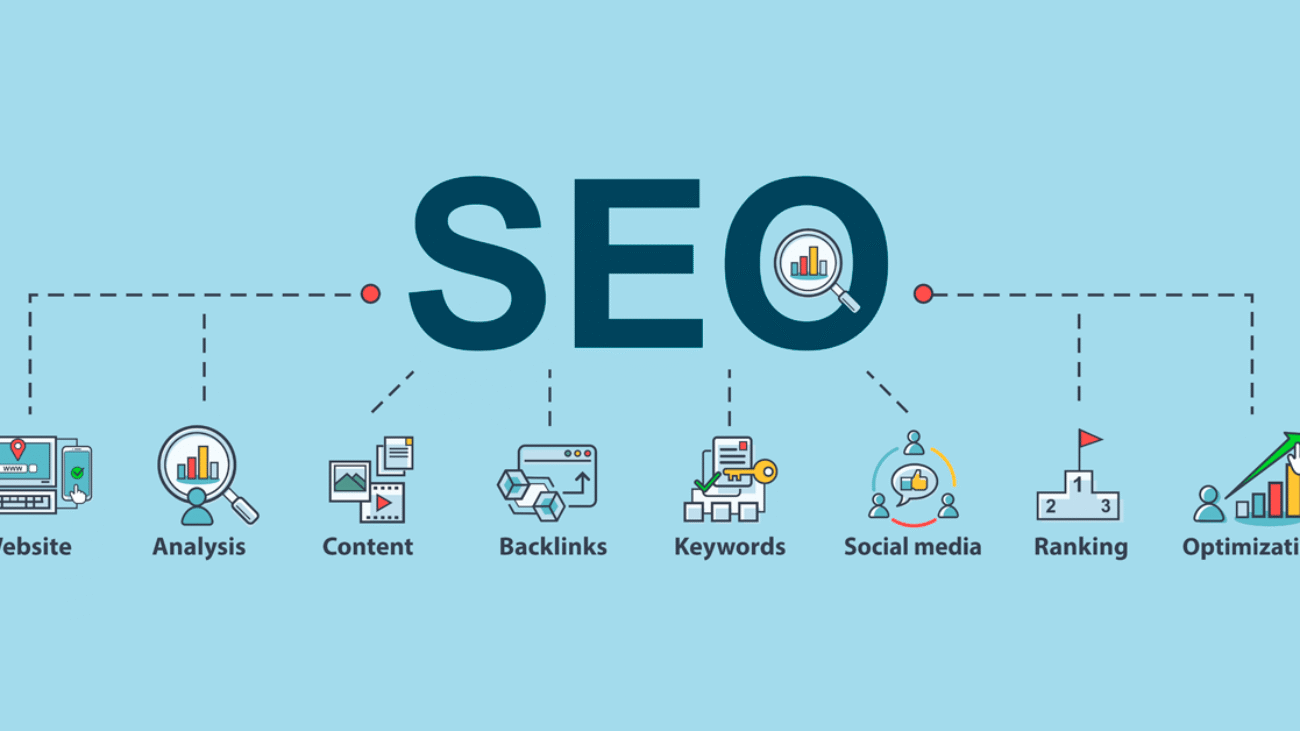Every SEO Beginner Needs a Glossary
Understanding SEO terms helps you:
-
Communicate better with clients, developers, and marketers
-
Make informed decisions about tools and strategies
-
Avoid common pitfalls in SEO implementation
-
Read SEO guides and audits with confidence
This glossary is organized alphabetically and tailored for foundations & fundamentals learning.
🔤 A to Z: Top 50 SEO Terms Explained
1. Alt Text
Alternative text describes images to search engines and visually impaired users. Important for accessibility and image SEO.
2. Anchor Text
The clickable text in a hyperlink. Google uses it to understand the context of linked content.
3. Backlink
A link from another website to your page. Also called “inbound link.” Crucial for domain authority and rankings.
4. Bounce Rate
Percentage of visitors who leave after viewing only one page. A high bounce rate can signal poor user engagement.
5. Canonical Tag
Tells search engines which version of a duplicate page is the “master.” Helps consolidate ranking signals.
6. Citations
Mentions of your business name/address/phone (NAP) on directories essential for local SEO.
7. Click-Through Rate (CTR)
The percentage of users who click on your link after seeing it in search results.
8. Cloaking
A black-hat SEO practice where the content shown to bots is different from what users see. Violates Google’s guidelines.
9. CMS (Content Management System)
Platforms like WordPress, Wix, or Shopify that help you build and manage websites.
10. Content Cluster
A group of interlinked pages organized around one pillar topic. Enhances topical authority.
11. Crawl Budget
The number of pages a search engine will crawl on your site within a given timeframe.
12. Crawl Errors
When search engines fail to access a page, often due to broken links or blocked resources.
13. Crawling
The process by which search engine bots discover your web pages.
14. CSS (Cascading Style Sheets)
Used to style and layout your web pages. Clean CSS helps improve loading speed.
15. DA (Domain Authority)
A Moz metric that estimates your site’s likelihood to rank on SERPs, based on backlinks and other signals.
16. De-indexed
When a page or entire site is removed from Google’s index meaning it won’t show up in search results.
17. Do-follow Link
A link that passes SEO value or “link juice” to the target page.
18. Duplicate Content
Identical or very similar content across multiple pages. Hurts SEO and confuses search engines.
19. Featured Snippet
A highlighted answer box shown above organic results. Known as “position zero.”
20. Google Search Console (GSC)
A free tool to monitor and maintain your site’s presence in Google Search.
21. Googlebot
Google’s web crawler that scans your website for content and updates.
22. Heading Tags (H1, H2, H3)
Used to structure content. H1 is for the main title, H2/H3 for subheadings. Helps both users and bots.
23. HTML (Hyper-Text Mark-up Language)
The backbone of web pages. Clean HTML = better crawling and rendering.
24. Impressions
The number of times your page is shown in search results, regardless of clicks.
25. Indexing
After crawling, search engines add your content to their index for potential rankings.
26. Internal Link
Links that go from one page to another within your website. Vital for crawlability and user flow.
27. Java-Script SEO
Optimizing how search engines crawl and index JS-heavy sites. Misuse can block content visibility.
28. Keyword
Words or phrases users type into search engines. Optimizing for them improves relevance and rankings.
29. Keyword Cannibalization
When multiple pages compete for the same keyword, weakening overall ranking potential.
30. LSI (Latent Semantic Indexing) Keywords
Related keywords that help give context to your content.
31. Local SEO
Optimizing your website to appear in local search results, including Google Maps and nearby “near me” queries.
32. Meta Description
A snippet that summarizes your page in search results. Doesn’t directly impact rankings but affects CTR.
33. Meta Tags
HTML tags that provide metadata like title, description, and robots instructions.
34. Mobile-First Indexing
Google primarily uses your site’s mobile version for indexing and ranking.
35. NAP (Name, Address, Phone Number)
Consistency of NAP is critical in local SEO for directory and citation management.
36. Noindex Tag
A meta tag that tells search engines not to index a particular page.
37. Off-Page SEO
Tactics outside your site that affect rankings like link building, PR, and social signals.
38. On-Page SEO
SEO strategies applied directly on your website content, keywords, structure, etc.
39. Organic Traffic
Visitors who land on your website through unpaid search engine results.
40. Page Speed
How fast your webpage loads. Affects UX and rankings. Optimize images, code, and server response time.
41. PPC (Pay Per Click)
A paid advertising model. While not SEO, it often works alongside it in search strategy.
42. Redirect
Used to send users and bots from one URL to another. Common types: 301 (permanent), 302 (temporary).
43. Robots.txt
A file that tells search engines which parts of your site to crawl or ignore.
44. Schema Mark up
Structured data that helps search engines understand and display rich results (reviews, FAQs, events).
45. Search Intent
The goal behind a user’s search informational, transactional, navigational, or commercial.
46. SERP (Search Engine Results Page)
The page you see after typing a query. Includes organic results, ads, snippets, and maps.
47. Sitemap
An XML file listing all URLs you want indexed. Helps bots discover content.
48. Slug
The part of a URL that identifies a page (e.g., /seo-glossary). Keep it short and keyword-rich.
49. SSL Certificate
Enables HTTPS on your site. Essential for security and Google’s trust.
50. UX (User Experience)
How easy and enjoyable it is to use your site. A major indirect SEO ranking factor.
✅ Bonus: SEO Terms Cheat Sheet PDF
Want to save this glossary as a printable PDF? I can generate a downloadable file so you can reference these terms while working on your SEO strategy.
🛠️ Practical Tips for Learning and Using SEO Terminology
Now that you’re equipped with the top 50 SEO terms, the next step is application. Knowing the words is only useful if you understand how they show up in real projects, so let’s look at how to use this glossary for real growth.
1. Apply Terms in Context
When you build a website, check if your headings follow H1, H2 structure. Are your anchor texts descriptive? Is your meta description clear and optimized?
For example, if you understand internal linking, start adding links between blog posts with relevant anchor text. Or test your knowledge of crawl budget by reviewing your sitemap and blocking low-priority pages in your robots.txt.
2. Use SEO Tools
Most SEO tools like Ahrefs, SEMrush, Moz, Screaming Frog, or Google Search Console use these terms throughout their interfaces. Understanding terminology helps you navigate reports, errors, and metrics more effectively.
-
Seeing “duplicate content”? Now you know it could affect your canonical tags or lead to a penalty.
-
Got a drop in organic traffic? Maybe your page speed or mobile-first index needs attention.
3. Join SEO Communities
Platforms like Reddit’s r/SEO, Twitter (X) SEO chats, and LinkedIn groups regularly discuss these topics. Seeing the terms used in real-time debates or case studies makes them stick.
4. Stay Updated
SEO evolves constantly. Google updates its algorithm frequently sometimes changing the value of a term overnight. Featured snippets, E-E-A-T, Core Web Vitals, and other newer terms weren’t even relevant five years ago.
Bookmark resources like:
-
Google Search Central
-
Moz Blog
-
Search Engine Journal
-
Ahrefs Blog
🚀 From Glossary to Action: Your Next SEO Move
This glossary isn’t just a beginner’s dictionary it’s your first SEO toolkit. Master these terms, and you’ll be able to:
-
Talk SEO confidently with clients or teammates
-
Understand reports and make data-driven decisions
-
Start your own SEO campaigns with strategic clarity
🧠 Final Thoughts: Learn the Language of SEO to Master It
Mastering SEO starts with understanding the vocabulary. These 50 terms form the foundation of every SEO strategy from content creation to technical audits and everything in between.
Whether you’re optimizing your first blog post or auditing a 10,000-page eCommerce site, this glossary gives you the language to act smarter, rank faster, and grow with clarity.


